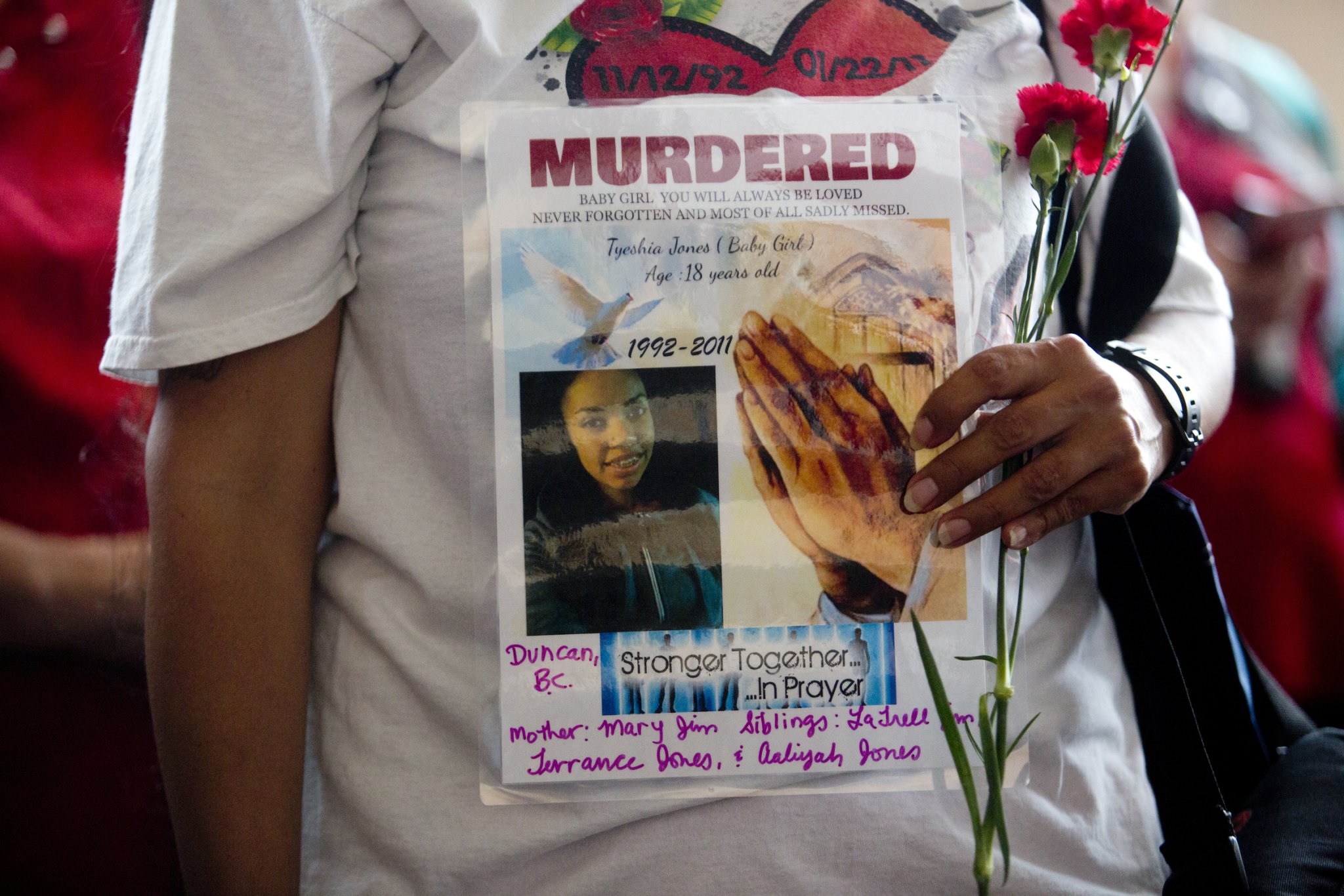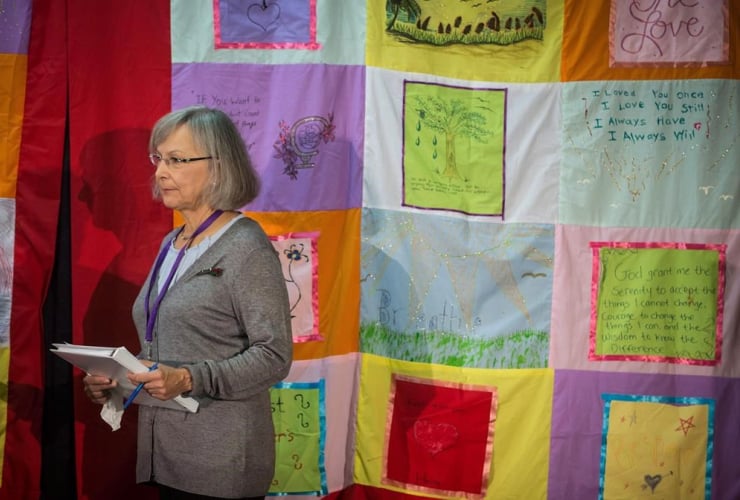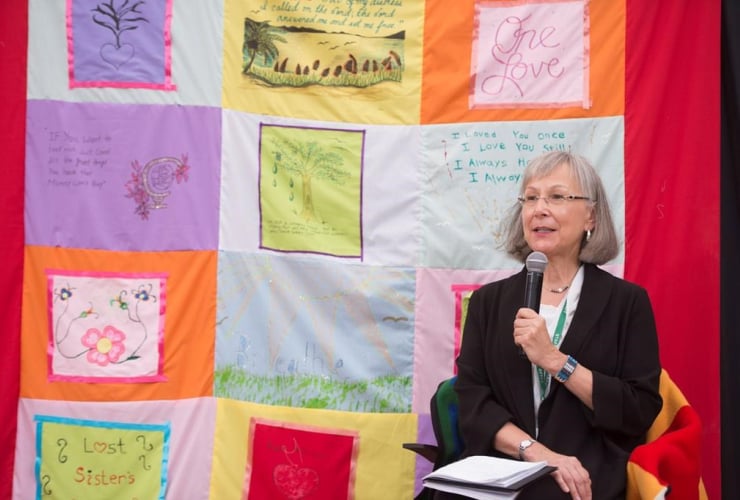After the national inquiry into missing and murdered Indigenous women released its final report this week, you may have seen a statistic claiming Indigenous men killed 70 per cent of murdered Indigenous women.
The number was cited by white nationalist Faith Goldy, former editor-in-chief of The Walrus magazine Jonathan Kay and reams of others on social media who sought to undermine the report's finding that Canada's treatment of Indigenous people is genocide.
Problem is, there’s no published research that supports the figure. It's based on years of sloppily collected RCMP data that doesn't examine the actual problems underlying violence against Indigenous women, and is grounded in racist assumptions about Indigenous people.
"What we have is people cherrypicking evidence and choosing evidence that supports their point of view without sharing with the public the limitations of what they're relying on, or putting that information in context," said Cindy Blackstock, executive director of the First Nations Child and Family Caring Society of Canada and member of the Gitksan First Nation.
"It's really disturbing to me, because how are we to engender an understanding in Canadians about the experiences and the contributions of First Nations, Métis and Inuit people when there's this kind of fabricated evidence being shared around?"
The federal government began the National Inquiry into Missing and Murdered Indigenous Women and Girls in late 2015, and appointed five commissioners the following August. For three years, the inquiry studied systemic violence against Indigenous women and girls, delivering its final report and recommendations Monday.
The final report included an entire section devoted to debunking the 70 per cent figure: "The often-cited statistic that Indigenous men are responsible for 70 per cent of murders of Indigenous women and girls is not factually based," it concluded.
According to the inquiry, the statistic first surfaced in March 2015 when then-Indigenous affairs minister Bernard Valcourt mentioned it in a meeting with several chiefs in Calgary, several months after claiming the issue with on-reserve violence was a lack of respect for women. The next month, then-RCMP commissioner Bob Paulson released a statement confirming the stat. However, the RCMP never divulged how it arrived at the number, which was never included in any official reports.
On Friday, reacting to a news story based on an advanced copy of the MMWIG report, Valcourt said on Twitter that the findings were "propagandist" and said it had come to a "thunderous silly conclusion." (The Conservative party later distanced itself, with Conservative MP Cathy McLeod, the shadow minister of Indigenous affairs, tweeting that Valcourt's comments were "unacceptable" and didn't represent the party's views.)
The inquiry's report also noted that, up until very recently, RCMP didn't even record whether victims or offenders were Indigenous. And such data that does exist was reported inconsistently. "The RCMP have not proven to Canada that they are capable of holding themselves to account — and, in fact, many of the truths shared here speak to ongoing issues of systemic and individual racism, sexism and other forms of discrimination that prevent honest oversight from taking place," the report said.
The 70 per cent figure also fails to account for the numerous missing and murdered Indigenous women and girls whose deaths weren't recorded as homicides, and leaves out unsolved cases, the inquiry found. After reviewing cases, the inquiry "believes that there were repeated instances... of police mischaracterizing disappearances and deaths as 'not suspicious," the report said.
"The fact is, that number is not substantiated," said commissioner Qajaq Robinson, a Nunavut-raised lawyer, who is not Indigenous. "It's also quite concerning that (this) kind of number and that kind of determination is being made when it's so clear that the data is incredibly unreliable."
Underlying the spread of the 70 per cent myth is a racist assumption that Indigenous people are inherently violent or uncivil, said Robert Henry, an assistant professor at the University of Calgary who studies Indigenous justice issues. It allows people who believe it to blame Indigenous men rather than examining their own roles in colonialism as it manifests today — something that must happen if society is to change in any meaningful way, he added.
"(The false statistic) maintains the idea that Indigenous men and Indigenous people are ... doing it to themselves and it's not part of the larger structural issues of colonialism that have impacted Indigenous people," Henry said. "We need the broader Canadian society to unlearn what we've learned and understand that we're all complicit in this."
Though it's wonderful that Canadians are engaging with the ideas in the report, Robinson said, it's "quite concerning" that some are quibbling over the finer points rather than figuring how to fix the enormous problems at play.
"Making those kinds of statements is dangerous and it mischaracterizes the situation," she added. "Debating semantics isn't going to get us there."
After the inquiry's final report was released, current RCMP Commissioner Brenda Lucki promised that the organization would review its findings and recommendations.
Violence does happen between Indigenous men and women, said Blackstock of the First Nations Child and Family Caring Society, but it's also important to understand the role intergenerational trauma caused by colonialism plays in that violence — the effects of residential schools and the Sixties Scoop, among other things, contribute to the cycle of violence.
The inquiry report also said men's healing must be part of the reconciliation process.
"It's not to excuse the behaviour," Blackstock said. "People need to be accountable and that behavior needs to end, but it is an additional contextual factor."
Thank you for posting this.
Thank you for posting this. It is comforting that although our understanding is incomplete we are not completely blind either.
I haven't read the portion of
I haven't read the portion of the report that addresses the 70% number. But, I have studied the stats in the statscan links listed below previously, also in the RCMP report, and other data available on line.
The solve rate for murders for indigenous and non-indigenous women are 76% and 84% respectively. The accused rate for murders for indigenous males is 11 times greater than non-aboriginal (according to 2017 statscan).
Indigenous women are 6x more likely to be the victim of murder than non-indigenous women. " In addition, in 2015, approximately 17 percent of Indigenous female victims and 18 percent of non-Indigenous female victims were on record as a missing person at the time the homicide became known to police" (https://femicideincanada.ca/about/trends).
One quarter of homicide victims in Canada are indigenous. Of solved murders in 2015, half of the female victims (48%) were murdered by a spouse or intimate partner, 22% by other family members (other than parents), 14% by casual acquaintances, 6% strangers, 6% by parents, 3% criminal acquaintances.
The vast majority of female victims are murder by males.
In other words, unless the argument is that murderers of indigenous women differ substantially from those of non-indigenous women (unlikely given the solve rates), then, like non-indigenous women, indigenous women are most likely to be murdered by a male, and most likely in a domestic violence event leaving 9% murdered by strangers and criminal acquaintances, and 14% by casual acquaintances (total 23%). Additionally, murder rates are higher in rural areas, and higher in prairie provinces (excluding gang violence in BC).
In other words, to argue it is not true that most indigenous women are murdered by indigenous males, one would have to argue female indigenous murder victims differ very significantly from non-indigenous, and / or female indigenous women are often in domestic relationships with non-indigenous males, and living in non-indigenous families. These possibilities seem unlikely, given the murder solve rates, and the fact the stats above include both indigenous and non-indigenous murder victims.
Here is one of the source
Here is one of the source documents that has been referred to.
RCMP says 7 of 10 female aboriginal homicides committed by aboriginal offenders. RCMP Commissioner Bob Paulson says in a letter to Grand Chief Bernice Martial of the Treaty Number 6 Nations.
The letter is available in this CBC article from 2015.
https://www.cbc.ca/news/politics/rcmp-says-7-of-10-female-aboriginal-hom...
There appears to be no access to the source NCMPUR database, so take it for what it is.
This is just for reference, I am not stating that the source data is or is not true.
(Your own bias will determine what you believe anyways)
The National Observer article
The National Observer article makes clear that there is no valid basis of the 70% number. Therefore it cannot be taken true or proven. Good discussion
Actually somebody came back
Actually somebody came back and debunked the Observer's debunking. Observer is well known for being a far left leaning media anyway but the Femicide statistics proved otherwise. All this article seems to be is damage control by the Liberal Government.
Another revelation about life
Another revelation about life in the First Nations is noticing that there are over twice as many missing and murdered men and boys as women and girls. Somebody must not have been looking very hard. https://equalitycanada.com/expandtheinquiry/
- ‹ previous
- 2 of 2






Comments